Detection of Crustal Uplift Deformation in Response to Glacier Wastage in Southern Patagonia
Abstract
1. Introduction
Study Area
2. Geodetic and Satellites Input Data
2.1. Continuous GPS Stations REFUGIO GREVE and GORRA BLANCA: Field Activities
2.2. GPS Episodic Stations: Upsala Glacier
2.3. GPS Accessory Data at Viedma Glacier
2.4. ICESat Data Profiles
2.5. SRTM Model
2.6. Gauging Data of Lake Viedma, O’Higgins and Chico
3. Geospatial Data Processing
3.1. Scientific Processing of the GPS Network
3.2. Geodetic GPS Data: Linkage to the Reference Frame
3.3. GPS Time Series Tendency and Seasonality Analysis
3.3.1. Robust Time-Series Data: Outlier Removal and Interpolation
3.3.2. Sifting Process
3.3.3. Seasonality Components
3.4. ICESat Profile Processing
4. Results
4.1. Velocities and Tendency of the Data Series
4.2. Tendency and Seasonality Analysis
Lake Variability Correlation with GPS Signal
4.3. Ice Elevation Changes
5. Discussion
Lake Seasonal Variability in GPS Time-Series
6. Conclusions
Author Contributions
Funding
Data Availability Statement
Acknowledgments
Conflicts of Interest
References
- Rivera, A.; Bown, F.; Napoleoni, F.; Muñoz, C. Balance de Masa Glaciar; Ediciones CECs: Valdivia, Chile, 2016; 203p. [Google Scholar]
- Millan, E.; Rignot, A.; Rivera, V.; Martineau, J.; Mouginot, R.; Zamora, J.; Uribe, G.; Lenzano, B.; De Fleurian, X.; Li, Y.; et al. Ice thickness and bed elevation of the Northern and Southern Patagonian Icefields. Geophys. Res. Lett. 2019, 46, 6626–6635. [Google Scholar] [CrossRef]
- IPCC. Summary for Policymakers. In Climate Change; The Physical Science Basis. Contribution of Working Group I to the Sixth Assessment Report of the Intergovernmental Panel on Climate Change; Cambridge University Press: Cambridge, MA, USA, 2021; in press. [Google Scholar]
- Aniya, M.; Skvarca, P. Characteristics and variation of Upsala and Moreno glaciers, southern Patagonia. Bull. Glaciers 1992, 39–53. [Google Scholar]
- Leiva, J.C.; Lenzano, L.; Cabrera, G.A. Geodetic and glaciological work at Glaciar Chico, South Patagonian Ice Field. Glob. Planet. Change 2004, 59, 10–16. [Google Scholar] [CrossRef]
- Rivera, A.; Bown, F.; Acuña, C.; Ordenes, F. Chilean glaciers as indicators of climate change. Terra Glacialis 2008, 11, 193–207. [Google Scholar]
- Rivera, A.; Corripio, J.; Bravo, C.; Cisternas, S. Glaciar Jorge Montt (Chilean Patagonia) dynamics derived from photos obtained by fixed cameras and satellite image feature tracking. Ann. Glaciol. 2012, 53, 152. [Google Scholar] [CrossRef]
- Willis, M.; Melkonian, A.; Pritchard, M.; River, A. Ice loss from the southern Patagonia Ice Field, South America, between 2000 and 2012. Geophys. Res. Lett. 2012, 39, L17501. [Google Scholar] [CrossRef]
- Mouginot, J.; Rignot, E. Ice motion of the Patagonian Icefields of South America: 1984–2014. Geophisical Res. Lett. 2015, 42, 2661. [Google Scholar] [CrossRef]
- Moragues, S.M.; Lenzano, M.G.; Lo Vecchio, A.; Falaschi, D.; Lenzano, L.E. Surface velocities of Upsala Glacier, Southern Patagonian Andes using cross correlation satellite imagery: 2013–2014 Period. Andean Geol. 2018, 45, 87–103. [Google Scholar] [CrossRef]
- Jaber, W.; Rott, H.; Floricioiu, D.; Wuite, J.; Miranda, N. Heterogeneous spatial and temporal pattern of surface elevation change and mass balance of the Patagonian ice fields between 2000 and 2016. Cryosphere 2019, 13, 2511–2535. [Google Scholar] [CrossRef]
- Richter, A.; Groh, A.; Horwath, M.; Ivins, E.; Marderwald, E.; Hormaechea, J.L.; Dietrich, R. The rapid and steady mass loss of the patagonian icefields throughout the GRACE era: 2002–2017. Remote Sens. 2019, 11, 909. [Google Scholar] [CrossRef]
- Vacaflor, P.; Lenzano, M.G.; Vich, A.; Lenzano, L. Co-Registration Methods and Error Analysis for Four Decades (1979–2018) of Glacier Elevation Changes in the Southern Patagonian Icefield. Remote Sens. 2022, 14, 820. [Google Scholar] [CrossRef]
- Minowa, M.; Schaefer, M.; Sugiyama, S.; Sakakibara, D.; Skvarca, P. Frontal ablation and mass loss of the Patagonian icefields. Earth Planet. Sci. Lett. 2021, 561, 116811. [Google Scholar] [CrossRef]
- Glasser, N.F.; Harrison, S.; Jansson, K.N.; Anderson, K.; Cowley, A. Global sea-level contribution from the Patagonian Icefields since the Little Ice Age maximum. Nat. Geosci. 2011, 4, 303–307. [Google Scholar] [CrossRef]
- Coulson, S.; Lubeck, M.; Mitrovica, J.X.; Powell, E.; Davis, J.L.; Hoggard, M.J. The global fingerprint of modern ice-mass loss on 3-D crustal motion. Geophys. Res. Lett. 2021, 48, e2021GL095477. [Google Scholar] [CrossRef]
- Peltier, W.R. Global Sea level rise and glacial isostatic adjustment. Glob. Planet. Change 1999, 20, 93–123. [Google Scholar] [CrossRef]
- Peltier, W.R. Ice age paleotopography. Science 1994, 265, 195–201. [Google Scholar] [CrossRef]
- Lange, H.; Casassa, G.; Ivins, E.; Schroeder, L.; Fritsche, M.; Richter, A.; Groh, A.; Dietrich, R. Observed crustal uplift near the Southern Patagonian Icefield constrains improved viscoelastic Earth models. Geophys. Res. Lett. 2014, 41, 805–812. [Google Scholar] [CrossRef]
- Even-Tzur, G. GPS vector configuration design for monitoring deformation networks. J. Geod. 2002, 76, 455–461. [Google Scholar] [CrossRef]
- Segall, P.; Davis, J. GPS applications for geodynamics and earthquake. Annu. Rev. Earth Planet. Sci. 1997, 25, 301–336. [Google Scholar] [CrossRef]
- Johnson, H.; Agnew, D.C. Correlated noise in the geodetic time series. U.S. Geol. Surv. 1995, 102, 591–603. [Google Scholar]
- Khan, S.A. Surface Deformations Analyzed Using GPS Time Series. PhD Thesis, Danish National Space Center, Lyngby, Denmark, 2005. [Google Scholar]
- Davies, B.J.; Glasser, N.F. Accelerating shrinkage of Patagonian glaciers from the Little Ice Age (~AD 1870) to 2011. J. Glaciol. 2012, 58, 1063–1084. [Google Scholar] [CrossRef]
- Dietrich, R.E.R.; Casassa, G.; Lange, H.; Wendt, J.; Fritsche, M. Rapid crustal uplift in Patagonia due to enhanced ice loss. Earth Planet. Sci. Lett. 2010, 289, 22–29. [Google Scholar] [CrossRef]
- Richter, A.; Ivins, E.; Lange, H.; Mendoza, L.; Schröder, L.; Hormaechea, J.L.; Horwath, M. Crustal deformation across the Southern Patagonian Icefield observed by GNSS. Earth Planet. Sci. Lett. 2016, 452, 206–215. [Google Scholar] [CrossRef]
- Casassa, G.; Rivera, A.; Aniya, M.; Naruse, R. Current knowledge of the southern Patagonia icefield. In The Patagonian Icefields; Springer: Boston, MA, USA, 2002; pp. 67–83. [Google Scholar] [CrossRef]
- Aniya, M. Holocene glaciations of Hielo Patagónico (Patagonia Icefield), South America: A brief review. Geochem. J. 2013, 47, 97–105. [Google Scholar] [CrossRef]
- De Angeli, H. Hypsometry and sensitivity of the mass balance to changes in equilibrium-line altitude: The case of the Southern Patagonia Icefield. J. Glaciol. 2014, 60, 14–28. [Google Scholar] [CrossRef]
- Moragues, S.N.; Lenzano, M.G.; Rivera, S.A.; Oberreuter, J.G.; Vich, A. Characterization and reconstruction of the Agassiz land- slide using geospatial data. Southern Patagonia, Argentina. Andgeo 2021, 48, 557. [Google Scholar] [CrossRef]
- Rivera, A.; Lenzano, M.; Lanutti, E.; Moragues, S.; Lenzano, L.; Lenz, A.J. Vich Estudio de la profundidad del lago Viedma, Parque Nacional Los Glaciares, Argentina. GEOACTA 2022, 43, 4–6. [Google Scholar]
- Normandeau, J.; Meertens, C.; Bartel, B. GPS antenna monuments and mounts supported by UNAVCO: Options and Effectiveness. AGU Fall Meet. Abstr. 2008, 2008, G41B-0627. [Google Scholar]
- Durand, M.; Lannutti, E.; Lenzano, M.G.; Lenzano, L.E. Evaluación del uso de diferentes antenas y la influencia de la no verticalidad en mediciones GPS. GEOACTA 2017, 42, 1–12. [Google Scholar]
- Lee, J. GLAS_HDF Standard Data Product Specification. 2012. Available online: https://icesat.gsfc.nasa.gov/icesat/hdf5_products/docs/GLAS_HDF_SDP.pdf (accessed on 5 October 2019).
- Abshire, J.B.; Sun, X.; Riris, H.; Sirota, J.M.; McGarry, J.F.; Palm, S.; Yi, D.; Liiva, P. Geoscience Laser Altimeter System (GLAS) on the ICESat Mission: On-Orbit Measurement Performance. Geophys. Res. Lett. 2005, 32, 24028. [Google Scholar] [CrossRef]
- Smith, B.; Fricker, H.A.; Gardner, A.; Siegfried, M.; Adusumilli, S.; Csathó, B.; Holschuh, N.; Nilsson, J.; Paolo, F.; the ICESat-2 Science Team. ATLAS/ICESat-2 L3A Land Ice Height Version 3; NASA National Snow and Ice Data Center Distributed Active Archive Center: Boulder, CO, USA, 2020.
- Neumann, T.A.; Martino, A.J.; Markus, T.; Bae, S.; Bock, M.R.; Brenner, A.C.; Brunt, K.M.; Cavanaugh, J.; Fernandes, S.T.; Hancock, D.W.; et al. The Ice, Cloud, and Land Elevation Satellite–2 Mission: A Global Geolocated Photon Product Derived from the Advanced Topographic Laser Altimeter System. Remote Sens. Environ. 2019, 233, 111325. [Google Scholar] [CrossRef] [PubMed]
- Farr, T.G.; Rosen, P.A.; Caro, E.; Crippen, R.; Duren, R.; Hensley, S.; Kobrick, M.; Paller, M.; Rodriguez, E.; Roth, L.; et al. The Shuttle Radar Topography Mission. Rev. Geophys 2007, 45, 183. [Google Scholar] [CrossRef]
- Dach, R.; Hugentobler, U.; Fridez, P.; Meindl, M. Bernese GPS software version 5.0. Astron. Inst. Univ. Bern 2007, 640, 114. [Google Scholar]
- Kouba, J. Implementation and testing of the gridded Vienna Mapping Function 1 (VMF1). J. Geod. 2008, 82, 193–205. [Google Scholar] [CrossRef]
- Fritsche, M.; Dietrich, R.; Knöfel, C.; Rülke, A.; Vey, S.; Rothacher, M.; Steigenberger, P. Impact of higher-order ionospheric terms on GPS estimates. Geophys. Res. Lett. 2005, 32, L23311. [Google Scholar] [CrossRef]
- Bevis, M.; Brown, A. Trajectory models and reference frames for crustal motion geodesy. J. Geod. 2014, 88, 283–311. [Google Scholar] [CrossRef]
- Rebischung, P.; Griffiths, J.; Ray, J.; Schmid, R.; Collilieux, X.; Garayt, B. IGS08: The IGS realization of ITRF2008. GPS Solut. 2012, 16, 483–494. [Google Scholar] [CrossRef]
- Chen, B.; Bian, J.; Ding, K.; Wu, H.; Li, H. Extracting seasonal signals in GNSS coordinate time series via weighted nuclear norm minimization. Remote Sens. 2020, 12, 2027. [Google Scholar] [CrossRef]
- Wang, K.; Jiang, W.; Chen, H.; An, X.; Zhou, X.; Yuan, P.; Chen, Q. Analysis of seasonal signal in GPS short-baseline time series. Pure Appl. Geophys. 2018, 175, 3485–3509. [Google Scholar] [CrossRef]
- Huang, N.E.; Shen, Z.; Long, S.R.; Wu, M.C.; Shih, H.H.; Zheng, Q.; Yen, N.-C.; Tung, C.C.; Liu, H.H. The Empirical Mode Decomposition and the Hilbert Spectrum for Nonlinear and Non-stationary Time Series Analysis. R. Soc. Proc. Math Phys. Eng. Sci. 1998, 454, 903–995. [Google Scholar] [CrossRef]
- Bao, Z.; Chang, G.; Zhang, L.; Chen, G.; Zhang, S. Filling missing values of multi-station GNSS coordinate time series based on matrix completion. Measurement 2021, 183, 109862. [Google Scholar] [CrossRef]
- Shen, Y.; Li, W.; Xu, G.; Li, B. Spatiotemporal filtering of regional GNSS network’s position time series with missing data using principle component analysis. J. Geod. 2014, 88, 1–12. [Google Scholar] [CrossRef]
- Yang, X.; Cheng, G.; Liu, H. Improved empirical mode decomposition algorithm of processing complex signal for IoT application. Int. J. Distrib. Sens. Netw. 2015, 11, 862807. [Google Scholar] [CrossRef]
- Huang, N.E.; Wu, Z. A review on Hilbert-Huang transform: Method and its applications to geophysical studies. Rev. Geophys. 2008, 46, RG2006. [Google Scholar] [CrossRef]
- Liu, Z.; Zhu, J.; Fu, H.; Zhou, C.; Zuo, T. Evaluation of the vertical accuracy of open global DEMs over steep terrain regions using icesat data: A case study over hunan province, china. Sensors 2020, 20, 4865. [Google Scholar] [CrossRef] [PubMed]
- Höhle, J.; Höhle, M. Accuracy Assessment of Digital Elevation Models by Means of Robust Statistical Methods. ISPRS J. Photogramm. Remote Sens. 2009, 64, 398–406. [Google Scholar] [CrossRef]
- Huber, P.J.; Ronchetti, E. Robust Statistics, 2nd ed.; Wiley Series in Probability and Statistics; Wiley: Hoboken, NJ, USA, 2009; ISBN 978-0-470-12990-6. [Google Scholar]
- Sánchez, L.; Drewes, H. Crustal deformation and surface kinematics after the 2010 earthquakes in Latin America. J. Geodyn. 2016, 102, 1–23. [Google Scholar] [CrossRef]
- Piñón, D.A.; Gómez, D.D.; Smalley, R.; Cimbaro, S.R.; Lauría, E.A.; Bevis, M.G. The History, State, and Future of the Argentine Continuous Satellite Monitoring Network and Its Contributions to Geodesy in Latin America. Seismol. Res. Lett. 2018, 89, 475–482. [Google Scholar] [CrossRef]
- Klos, A.; Bos, M.S.; Bogusz, J. Detecting time-varying seasonal signal in GPS position time series with different noise levels. GPS Solut. 2018, 22, 21. [Google Scholar] [CrossRef]
- Gómez, D.D.; Bevis, M.G.; Smalley, R.; Durand, M.; Willis, M.J.; Caccamise, D.J.; Casassa, G. Transient ice loss in the Patagonia Icefields during the 2015–2016 El Niño event. Sci. Rep. 2022, 12, 1–8. [Google Scholar]
- Malz, P.; Meier, W.; Casassa, G.; Jaña, R.; Skvarca, P.; Braun, M.H. Elevation and mass changes of the Southern Patagonia Icefield derived from TanDEM-X and SRTM data. Remote Sens. 2019, 10, 188. [Google Scholar] [CrossRef]
- Lenzano, M.G.; Lannutti, E.; Toth, C.; Rivera, A.; Lenzano, L. Detecting glacier surface motion by optical flow. Photogramm. Eng. Remote Sens. 2018, 84, 33–42. [Google Scholar] [CrossRef]
- Breitsprecher, K.; Thorkelson, D.J. Neogene kinematic history of Nazca–Antarctic–Phoenix slab windows beneath Patagonia and the Antarctic Peninsula. Tectonophysics 2009, 464, 10–20. [Google Scholar] [CrossRef]
- Russo, R.M.; VanDecar, J.C.; Comte, D.; Mocanu, V.I.; Gallego, A.; Murdie, R.E. Subduction of the Chile Ridge: Upper mantle structure and flow. Gsa Today 2010, 20, 4–10. [Google Scholar] [CrossRef]
- Rabassa, J.; Coronato, A.; Martinez, O. Late Cenozoic glaciations in Patagonia and Tierra del Fuego: An updated review. Biol. J. Linn. Soc. 2011, 103, 316–335. [Google Scholar] [CrossRef]
- Ávila, P.; Dávila, F.M. Heat flow and lithospheric thickness analysis in the Patagonian asthenospheric windows, southern South America. Tectonophysics 2018, 747, 99–107. [Google Scholar] [CrossRef]
- Ávila, P.; Dávila, F.M. Lithospheric thinning and dynamic uplift effects during slab window formation, southern Patagonia (45°–55° S). J. Geodyn. 2020, 133, 101689. [Google Scholar] [CrossRef]
- Mark, H.F.; Wiens, D.A.; Ivins, E.R.; Richter, A.; Ben Mansour, W.; Magnani, M.B.; Marderwald, E.; Adaros, R.; Barrientos, S. Lithospheric erosion in the Patagonian slab window, and implications for glacial isostasy. Geophys. Res. Lett. 2022, 49, e2021GL096863. [Google Scholar] [CrossRef]
- Ivins, E.R.; James, T.S. Bedrock response to Llanquihue Holocene and present-day glaciation in southernmost South America. Geophys. Res. Lett. 2004, 31, L24613. [Google Scholar] [CrossRef]
- Folguera, A.; Gianni, G.; Sagripanti, L.; Vera, E.R.; Colavitto, B.; Orts, D.; Ramos, V.A. Active Deformation, Uplift and Subsidence in Southern South America Throughout the Quaternary: A General Review About Their Development and Mechanisms. In Marine Isotope Stage 3 in Southern South America; 60 KA BP-30 KA BP; Springer: Cham, Switzerland, 2016; pp. 107–127. [Google Scholar]
- Richter, A.J.; Marderwald, E.R.; Hormaechea, J.L.; Mendoza, L.P.O.; Perdomo, R.A.; Connon, G.C.; Dietrich, R. Lake-level variations and tides in Lago Argentino, Patagonia: Insights from pressure tide gauge records. J. Limnol. 2016, 75, 62–77. [Google Scholar] [CrossRef]
- Pereira, A.; Cornero, C.; Matos, A.C.; Pacino, M.C.; Blitzkow, D. Detection of total water mass changes in the Patagonian glaciers area by satellite gravimetry. Geofísica Int. 2021, 60, 161–174. [Google Scholar] [CrossRef]
- Nicolas, J.; Verdun, J.; Boy, J.-P.; Bonhomme, L.; Asri, A.; Corbeau, A.; Berthier, A.; Durand, F.; Clarke, P. Improved Hydrological Loading Models in South America: Analysis of GPS Displacements Using M-SSA. Remote Sens. 2021, 13, 1605. [Google Scholar] [CrossRef]
- Yan, J.; Dong, D.; Bürgmann, R.; Materna, K.; Tan, W.; Peng, Y.; Chen, J. Separation of sources of seasonal uplift in China using independent component analysis of GNSS time series. J. Geophys. Res. Solid Earth 2019, 124, 11951–11971. [Google Scholar] [CrossRef]
- Carabajal, C.; Boy, J.P. Lake and reservoir volume variations in South America from radar altimetry, ICESat laser altimetry, and GRACE time-variable gravity. Adv. Space Res. 2021, 68, 652–671. [Google Scholar] [CrossRef]
- Blewitt, G.; Lavallée, D. Effect of annual signals on geodetic velocity. J. Geophys. Res. Solid Earth 2002, 107, ETG-9. [Google Scholar] [CrossRef]
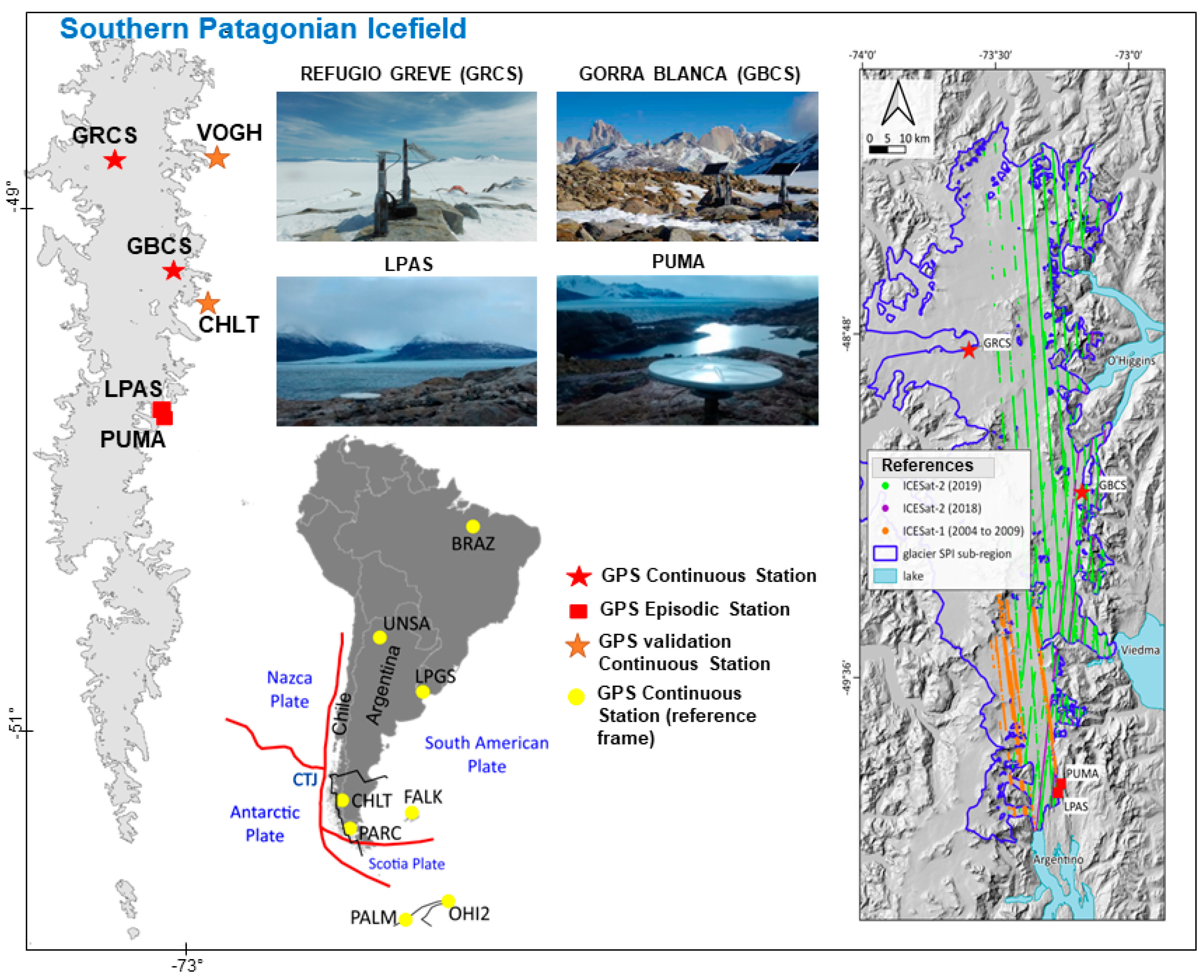
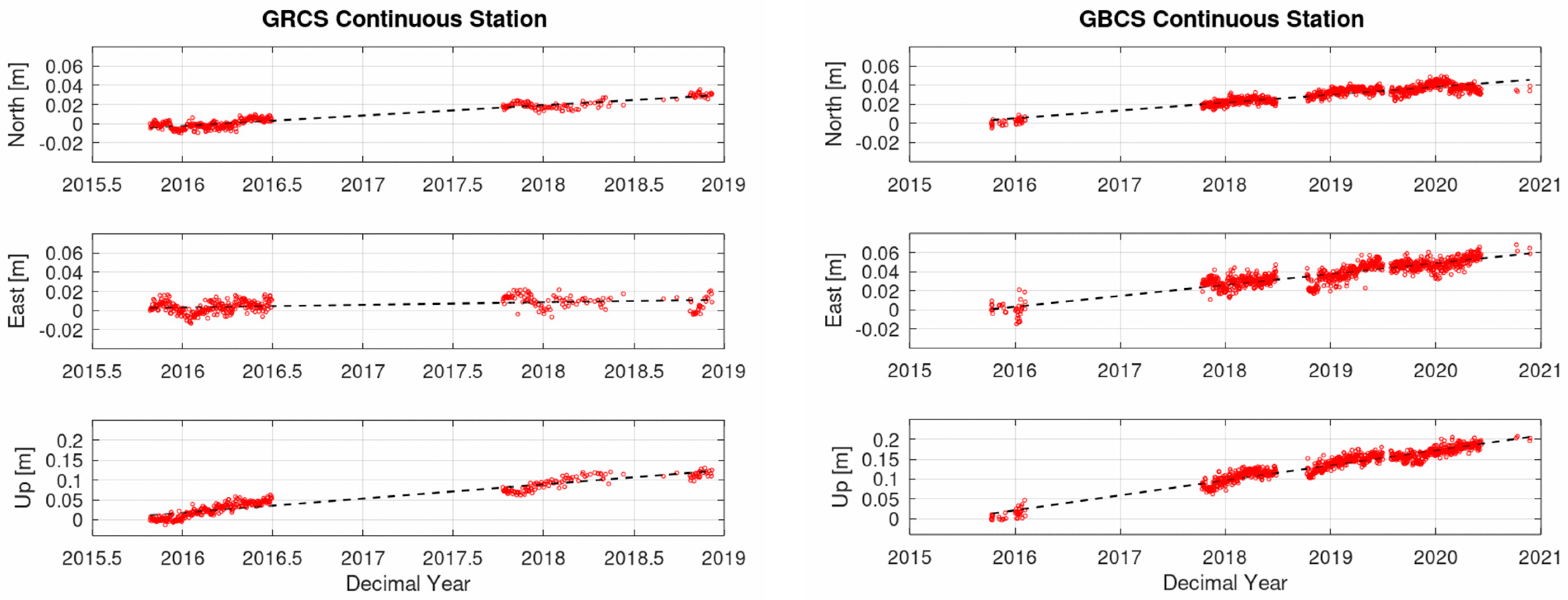
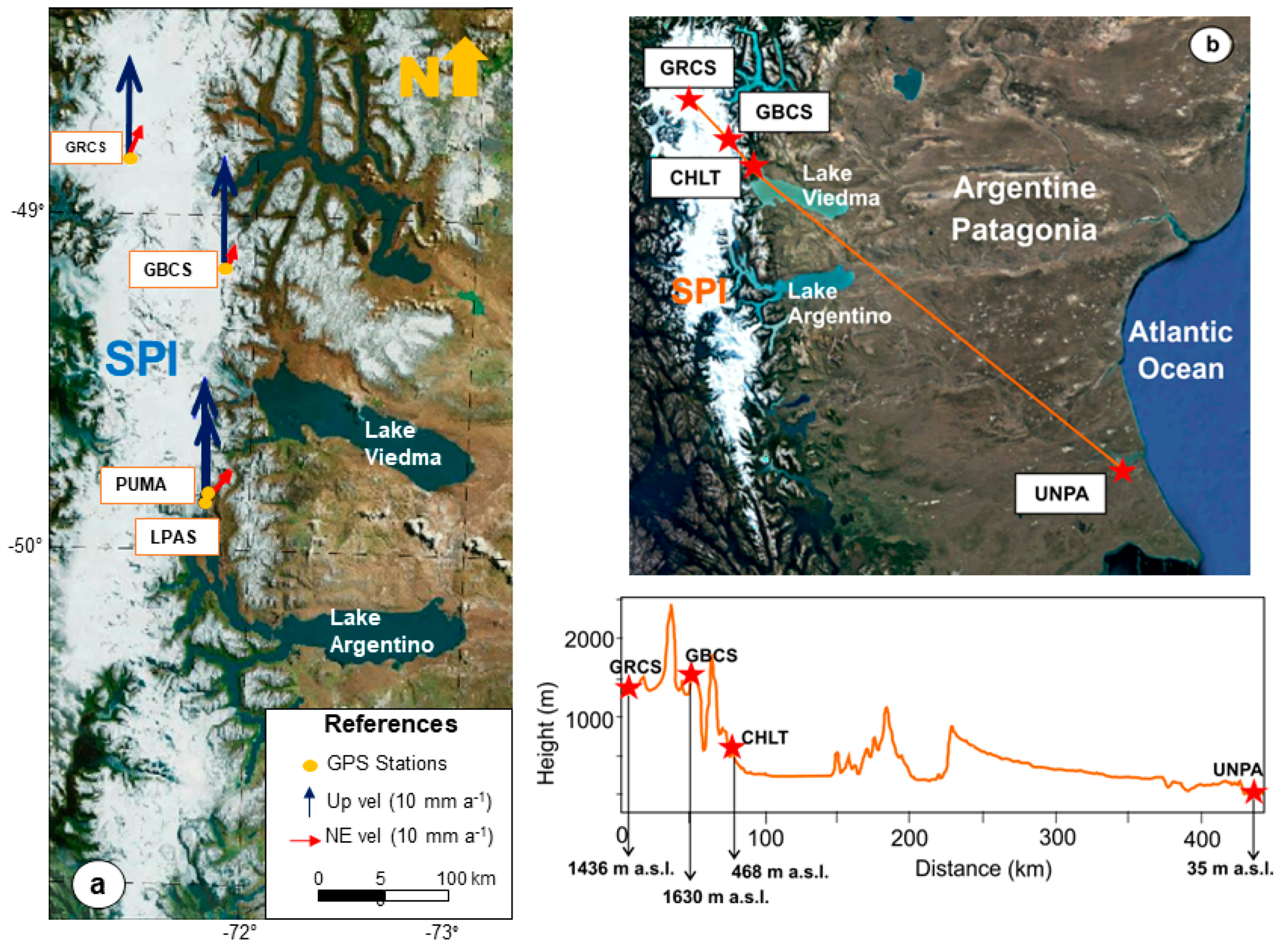
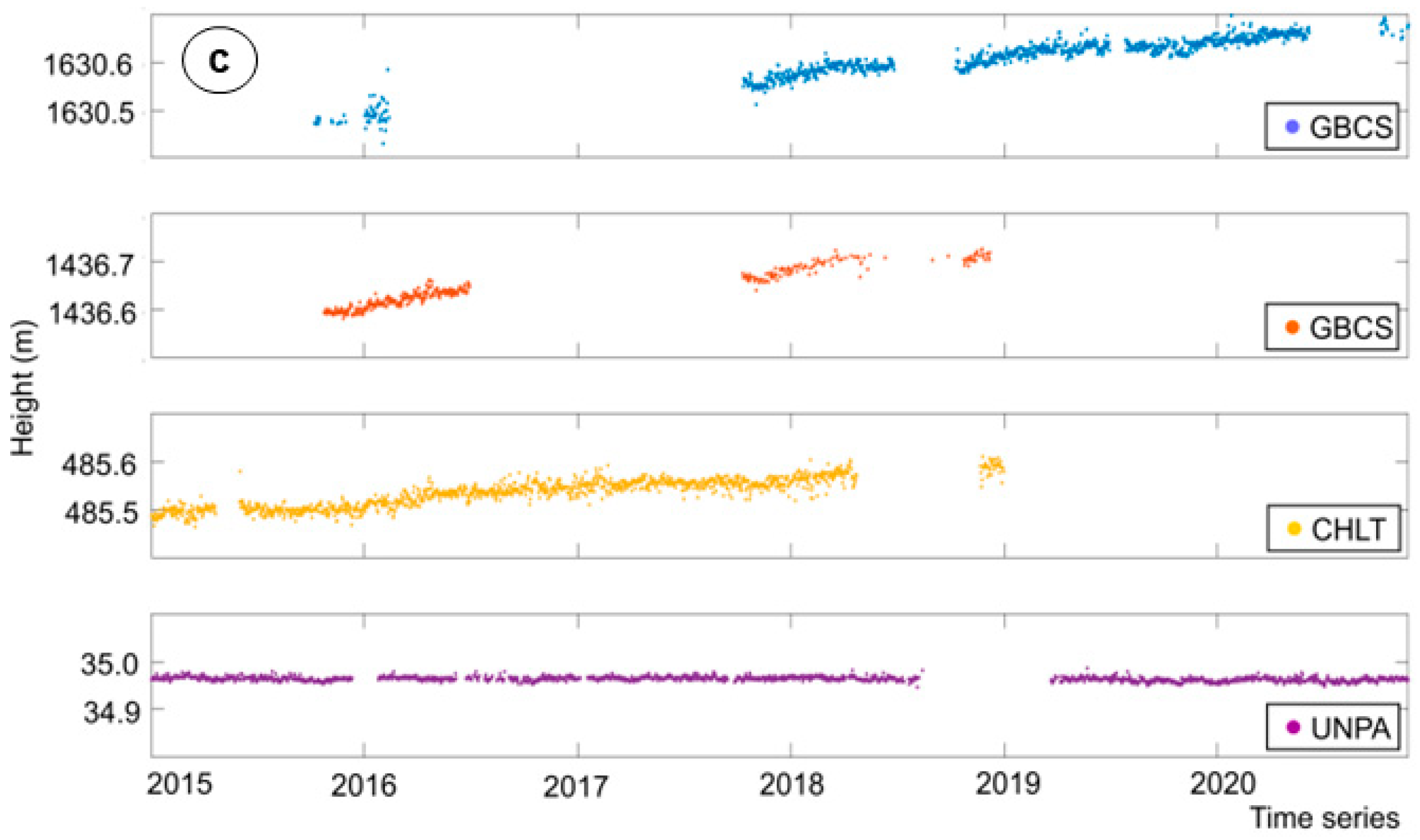


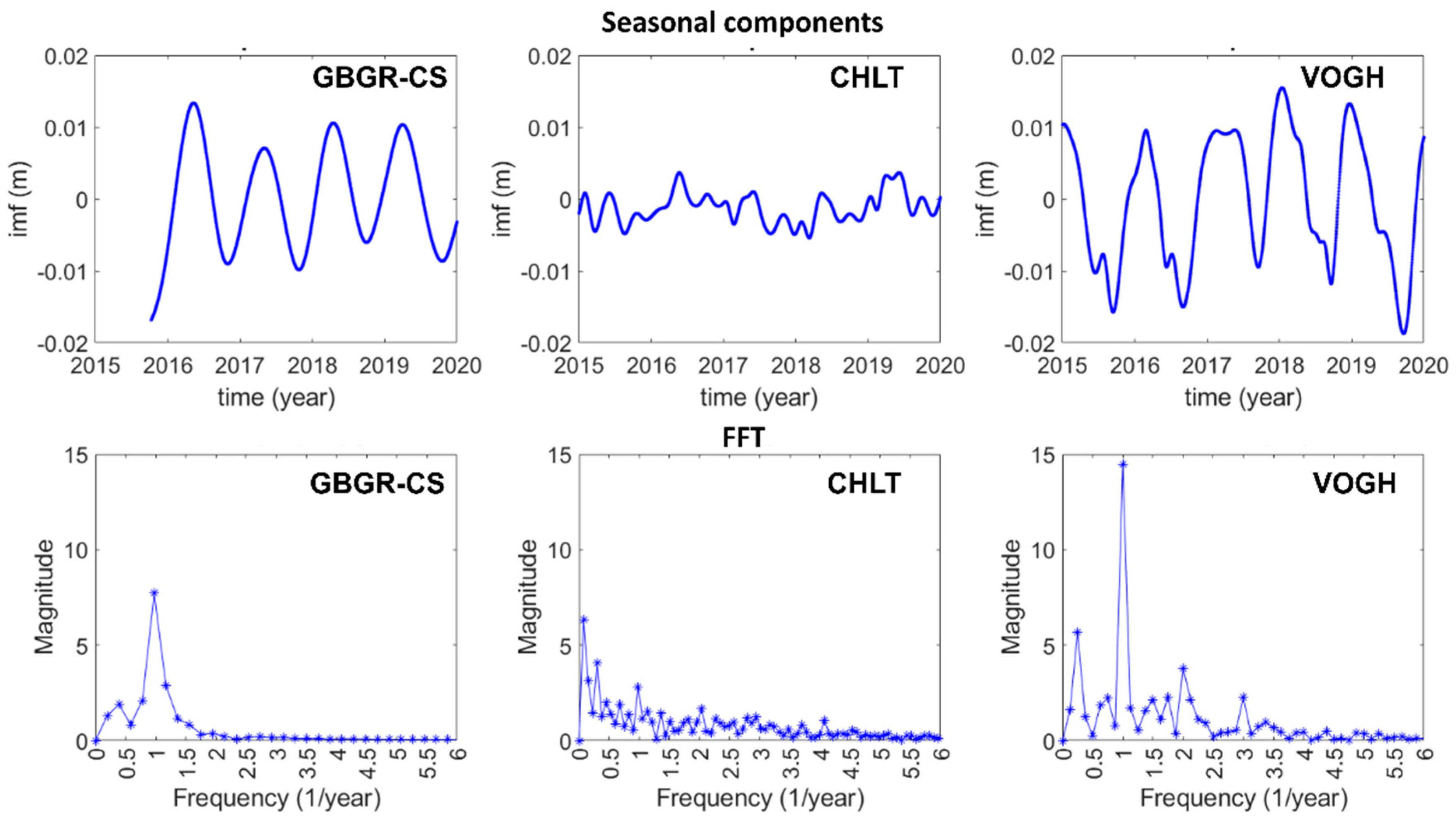
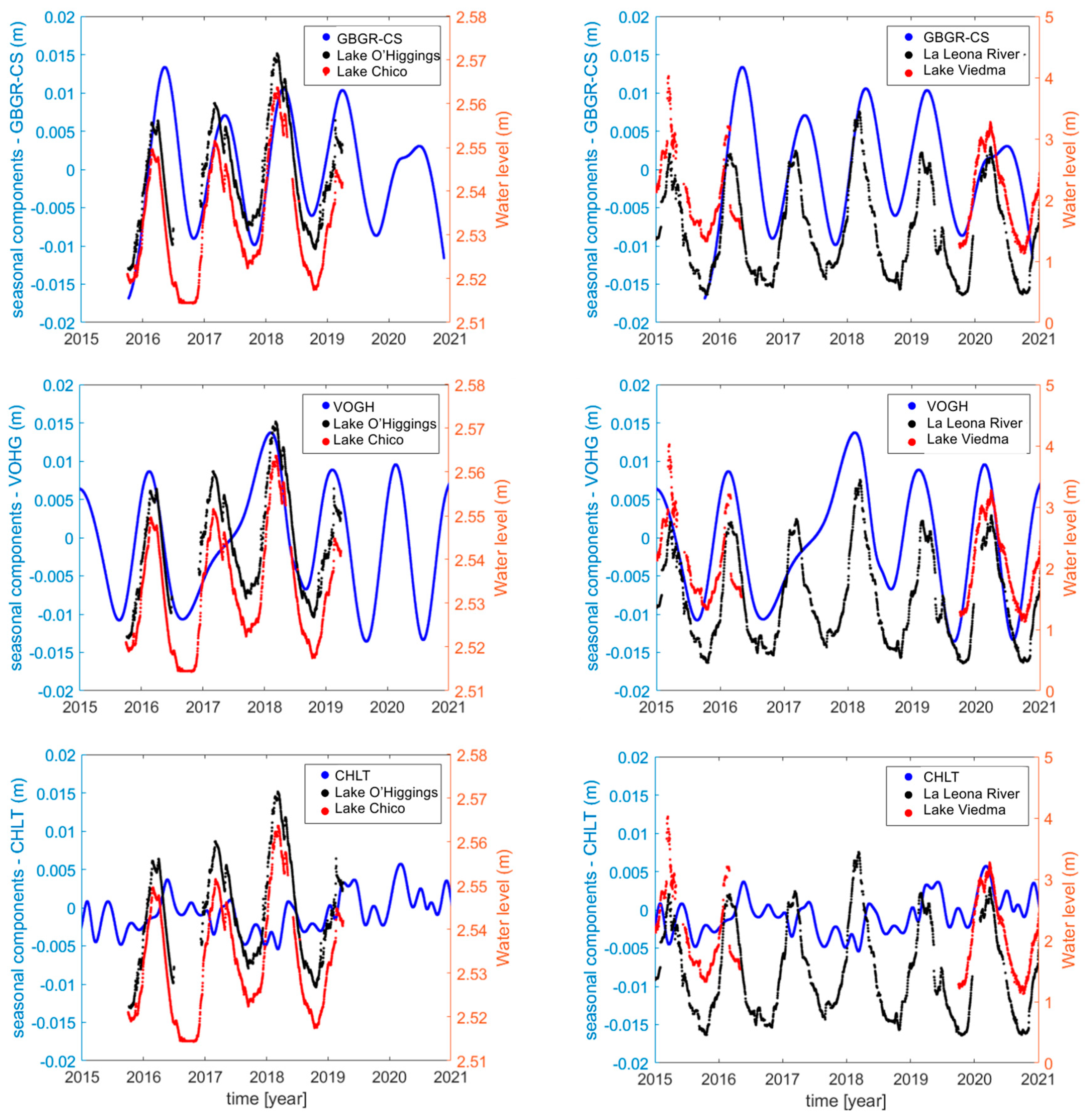
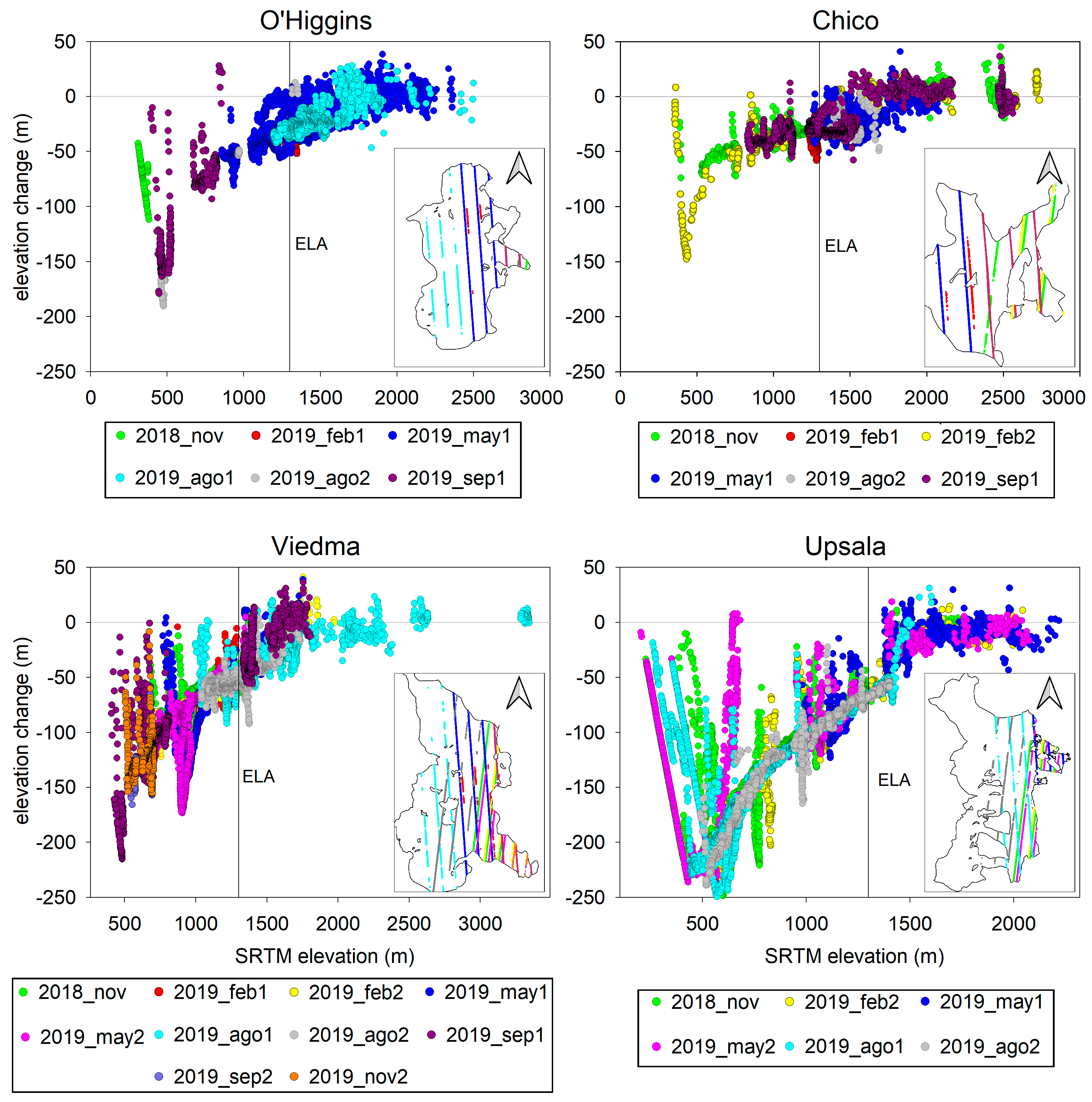
| Site | Type | Height (m a.s.l.) | Year | Start Date | End Date | Total Days |
|---|---|---|---|---|---|---|
| GBCS | Continuous | 1630 | 2015 | 8 October | 30 November | 911 |
| 2016 | 4 January | 5 March | ||||
| 2017 | 9 October | 31 December | ||||
| 2018 | 1 January | 26 June | ||||
| 9 October | 31 December | |||||
| 2019 | 1 January | 28 May | ||||
| 28 July | 31 December | |||||
| 2020 | 1 January | 6 June | ||||
| 7 October | 23 November | |||||
| GRCS | Continuous | 1436 | 2015 | 24 October | 31 December | 378 |
| 2016 | 1 January | 11 July | ||||
| 2017 | 9 October | 31 December | ||||
| 2018 | 1 January | 18 June | ||||
| LPAS | Episodic | 754 | 2015 | 18 April | 20 April | 12 |
| 2016 | 19 April | 21 April | ||||
| 23 October | 25 October | |||||
| 2017 | 17 April | 19 April | ||||
| PUMA | Episodic | 807 | 2015 | 18 April | 20 April | 12 |
| 2016 | 18 April | 20 April | ||||
| 22 October | 25 October | |||||
| 2017 | 17 April | 19 April |
| File Name | Acquisition Date | Laser Campaign (I(ICESat-1)) /G GTN * Used (I(ICESat-2)) | Footprint Size | |
|---|---|---|---|---|
| Major Axis Mean ± St. Dev. | Eccentricity Mean ± St. Dev. | |||
| GLAH14_634_2107_002_0043_0_01_0001 | 25 February 2004 | L2B | 89.52 ± 4.93 | 0.822 ± 0.045 |
| 2107_003_0043_0_01_0001 | 26 May 2004 | L2C | 88.37 ± 19.12 | 0.892 ± 0.044 |
| 2109_002_0043_0_01_0001 | 12 October 2004 | L3A | 55.79 ± 0.43 | 0.567 ± 0.043 |
| 2111_002_0043_0_01_0001 | 27 February 2005 | L3B | 79.53 ± 11.55 | 0.753 ± 0.051 |
| 2113_002_0043_0_01_0001 | 30 October 2005 | L3D | 52.04 ± 1.06 | 0.523 ± 0.010 |
| 2115_002_0043_0_01_0001 | 2 March 2006 | L3E | 52.31 ± 1.60 | 0.483 ± 0.040 |
| 2119_002_0043_0_01_0001 | 20 March 2007 | L3H | 55.61 ± 0.48 | 0.521 ± 0.019 |
| 2121_002_0043_0_01_0001 | 11 October 2007 | L3I | 57.28 ± 0.57 | 0.590 ± 0.013 |
| 2123_002_0043_0_01_0001 | 25 February 2008 | L3J | 58.66 ± 1.52 | 0.575 ± 0.036 |
| 2125_002_0043_0_01_0001 | 12 October 2008 | L3K | 51.99 ± 1.12 | 0.611 ± 0.036 |
| ATL06_20181126060903_08950109_005_01 | 26 November 2018 | 1-2-3-4-5-6 | 17 m | |
| 20190206150633_06130213_005_01 | 6 February 2019 | 1-2-3-5-6 | ||
| 20190225014905_08950209_005_01 | 25 February 2019 | 3-4-5-6 | ||
| 20190508104610_06130313_005_01 | 8 May 2019 | 1-2-3-4-5-6 | ||
| 20190526212840_08950309_005_01 | 26 May 2019 | 1-2-3-4-5-6 | ||
| 20190807062551_06130413_005_01 | 7 August 2019 | 1-2-3-4-5-6 | ||
| 20190825170829_08950409_005_01 | 25 August 2019 | 1-2-3-4-5-6 | ||
| 20190905050156_10550413_005_01 | 5 September 2019 | 1-2-3-4-5-6 | ||
| 20190923154435_13370409_005_01 | 23 September 2019 | 6 | ||
| 20191124124821_08950509_005_01 | 24 November 2019 | 3-4-5-6 | ||
| 20191205004146_10550513_005_01 | 5 December 2019 | 1-2-3-4-5-6 | ||
| Station | City—Country | Height (m a.s.l.) | Plate | Agency |
|---|---|---|---|---|
| BRAZ | Brasilia, Brazil | 1106 | South American (SOAM) | IGS |
| UNSA | Salta, Argentine | 1257 | South American (SOAM) | IGS |
| FALK | Islas Malvinas | 50 | South American (SOAM) | IGS |
| LPGS | La Plata, Argentine | 29 | South American (SOAM) | IGS |
| OHI2 | O’Higgins, Antarctica | 33 | Antarctica (ANTA) | IGS |
| PALM | Estación Palmer, Antarctica | 31 | Antarctica (ANTA) | IGS |
| PARC | Punta Arenas, Chile | 22 | South American (SOAM) | IGS |
| CHLT | Santa Cruz, Argentine | 485 | South American (SOAM) | IGN-Ar |
| VOGH * | Chile | 301 | South American (SOAM) | IGS |
| Site | Vel N (mm a−1) | σN (mm a−1) | Vel E (mm a−1) | σE (mm a−1) | Vel Up (mm a−1) | σUp (mm a−1) |
|---|---|---|---|---|---|---|
| GBCS | 7.87 | 0.50 | 3.33 | 2.11 | 37.16 | 2.10 |
| GRCS | 10.20 | 0.63 | 3.15 | 1.12 | 33.03 | 2.14 |
| LPAS | 8.70 | 1.09 | 12.30 | 1.23 | 34.00 | 5.03 |
| PUMA | 5.40 | 1.09 | 11.30 | 1.23 | 20.30 | 5.03 |
| Lake Gauges | GBGR-CS | CHLT | VOGH |
|---|---|---|---|
| Chico | 0.6736 | 0.0603 | 0.4858 |
| O’Higgins | 0.6269 | −0.0796 | 0.6431 |
| La Leona | 0.3797 | 0.1429 | 0.6718 |
| Viedma | 0.0264 | 0.2272 | 0.6365 |
| ICESat Date | ICESat Data Quantity | (m) | Annual (m) | Time Elapsed | Time Elapsed (Years) | (m a−1) | Annual (m a−1) |
|---|---|---|---|---|---|---|---|
| Accumulation Zone | |||||||
| SRTM-ICESat-1 (2000–2004/8) | |||||||
| February 2004 | 36 | −6.23 ± 1.11 | −6.61 ± 0.69 | 4.0 | 4.31 | −1.56 ± 0.28 | −1.53 ± 0.16 |
| May 2004 | 38 | −7.94 ± 1.94 | 4.25 | −1.87 ± 0.46 | |||
| October 2004 | 31 | −5.19 ± 1.33 | 4.67 | −1.11 ± 0.28 | |||
| February 2005 | 75 | −10.60 ± 0.64 | −10.55 ± 0.48 | 5.0 | 5.33 | −2.12 ± 0.13 | −1.98 ± 0.09 |
| October 2005 | 99 | −10.47 ± 0.45 | 5.67 | −1.85 ± 0.08 | |||
| March 2006 | 92 | −15.67 ± 1.58 | −15.67 ± 1.58 | 6.08 | 6.08 | −2.58 ± 0.26 | −2.58 ± 0.26 |
| March 2007 | 51 | −13.68 ± 0.34 | −13.13 ± 0.66 | 7.08 | 7.38 | −1.93 ± 0.05 | −1.78 ± 0.09 |
| October 2007 | 117 | −13.07 ± 0.62 | 7.67 | −1.70 ± 0.08 | |||
| February 2008 | 51 | −17.57 ± 1.07 | −16.78 ± 0.63 | 8.0 | 8.34 | −2.20 ± 0.13 | −2.01 ± 0.08 |
| October 2008 | 68 | −16.19 ± 0.88 | 8.67 | −2.87 ± 0.10 | |||
| SRTM-ICESat-2 (2000–2019) | |||||||
| 26 November 2018 | 3771 | −24.47 ± 0.13 | −24.47 ± 0.13 | 18.74 | 18.74 | −1.31 ± 0.01 | −1.31 ± 0.01 |
| 6 February 2019 | 671 | −18.09 ± 0.31 | −18.13 ± 0.04 | 18.93 | 19.31 | −0.96 ± 0.02 | −0.94 ± 0.01 |
| 25 February 2019 | 2187 | −10.85 ± 0.17 | 18.99 | −0.57 ± 0.01 | |||
| 8 May 2019 | 23,036 | −19.61 ± 0.06 | 19.18 | −1.02 ± 0.01 | |||
| 26 May 2019 | 675 | −14.85 ± 0.33 | 19.23 | −0.77 ± 0.02 | |||
| 7 August 2019 | 8898 | −22.61 ± 0.08 | 19.43 | −1.16 ± 0.01 | |||
| 25 August 2019 | 3147 | −31.28 ± 0.18 | 19.48 | −1.61 ± 0.01 | |||
| 5 September 2019 | 7361 | −1.80 ± 0.14 | 19.51 | −0.09 ± 0.01 | |||
| 5 December 2019 | 2872 | −15.32 ± 0.24 | 19.76 | −0.78 ± 0.01 | |||
| Ablation zone | |||||||
| SRTM-ICESat-1 (2000–2004/8) | |||||||
| February 2004 | 127 | −10.07 ± 0.59 | −10.54 ± 0.37 | 4.0 | 4.31 | −2.52 ± 0.15 | −2.45 ± 0.08 |
| May 2004 | 131 | −10.90 ± 1.05 | 4.25 | −2.56 ± 0.25 | |||
| October 2004 | 111 | −10.42 ± 0.70 | 4.67 | −2.23 ± 0.15 | |||
| February 2005 | 47 | −22.26 ± 0.80 | −18.14 ± 0.58 | 5.0 | 5.33 | −4.45 ± 0.16 | −3.39 ± 0.11 |
| October 2005 | 72 | −17.25 ± 0.53 | 5.67 | −3.04 ± 0.09 | |||
| March 2006 | 32 | −30.94 ± 2.68 | −30.94 ± 2.68 | 6.08 | 6.08 | −5.09 ± 0.44 | −5.09 ± 0.44 |
| March 2007 | 44 | −27.21 ± 0.37 | −40.49 ± 1.01 | 7.08 | 7.38 | −3.84 ± 0.05 | −5.49 ± 0.14 |
| October 2007 | 27 | −43.54 ± 1.30 | 7.67 | −5.68 ± 0.17 | |||
| February 2008 | 30 | −39.08 ± 1.04 | −33.75 ± 0.78 | 8.0 | 8.34 | −4.08 ± 0.17 | −4.05 ± 0.09 |
| October 2008 | 48 | −16.19 ± 0.88 | 8.67 | −4.51 ± 0.12 | |||
| October 2009 | 38 | −33.61 ± 1.73 | −33.61 ± 1.73 | 9.67 | −3.48 ± 0.18 | −4.03 ± 0.18 | |
| SRTM-ICESat-2 (2000−2019) | |||||||
| 26 November 2018 | 10,901 | −76.27 ± 0.07 | −76.27 ± 0.07 | 18.74 | 18.74 | −4.07 ± 0.01 | −4.07 ± 0.01 |
| 6 February 2019 | 1841 | −46.96 ± 0.19 | −64.97 ± 0.04 | 18.93 | 19.31 | −2.48 ± 0.01 | −3.36 ± 0.01 |
| 25 February 2019 | 3359 | −57.86 ± 0.14 | 18.99 | −3.05 ± 0.01 | |||
| 8 May 2019 | 11,842 | −50.51 ± 0.06 | 19.18 | −2.63 ± 0.01 | |||
| 26 May 2019 | 6859 | −93.08 ± 0.10 | 19.23 | −4.84 ± 0.02 | |||
| 7 August 2019 | 10,754 | −74.33 ± 0.07 | 19.43 | −3.83 ± 0.01 | |||
| 25 August 2019 | 7824 | −62.21 ± 0.11 | 19.48 | −3.19 ± 0.01 | |||
| 5 September 2019 | 8549 | −53.83 ± 0.13 | 19.51 | −2.76 ± 0.01 | |||
| 23 September 2019 | 256 | −120.07 ± 0.42 | 19.56 | −6.14 ± 0.02 | |||
| 6 November 2019 | 897 | −118.63 ± 0.24 | 19.73 | −6.01 ± 0.01 | |||
| 24 November 2019 | 5833 | −44.22 ± 0.17 | 19.76 | −2.24 ± 0.01 | |||
Disclaimer/Publisher’s Note: The statements, opinions and data contained in all publications are solely those of the individual author(s) and contributor(s) and not of MDPI and/or the editor(s). MDPI and/or the editor(s) disclaim responsibility for any injury to people or property resulting from any ideas, methods, instructions or products referred to in the content. |
© 2023 by the authors. Licensee MDPI, Basel, Switzerland. This article is an open access article distributed under the terms and conditions of the Creative Commons Attribution (CC BY) license (https://creativecommons.org/licenses/by/4.0/).
Share and Cite
Lenzano, M.G.; Rivera, A.; Durand, M.; Vacaflor, P.; Carbonetti, M.; Lannutti, E.; Gende, M.; Lenzano, L. Detection of Crustal Uplift Deformation in Response to Glacier Wastage in Southern Patagonia. Remote Sens. 2023, 15, 584. https://doi.org/10.3390/rs15030584
Lenzano MG, Rivera A, Durand M, Vacaflor P, Carbonetti M, Lannutti E, Gende M, Lenzano L. Detection of Crustal Uplift Deformation in Response to Glacier Wastage in Southern Patagonia. Remote Sensing. 2023; 15(3):584. https://doi.org/10.3390/rs15030584
Chicago/Turabian StyleLenzano, María Gabriela, Andrés Rivera, Marcelo Durand, Paulina Vacaflor, Micaela Carbonetti, Esteban Lannutti, Mauricio Gende, and Luis Lenzano. 2023. "Detection of Crustal Uplift Deformation in Response to Glacier Wastage in Southern Patagonia" Remote Sensing 15, no. 3: 584. https://doi.org/10.3390/rs15030584
APA StyleLenzano, M. G., Rivera, A., Durand, M., Vacaflor, P., Carbonetti, M., Lannutti, E., Gende, M., & Lenzano, L. (2023). Detection of Crustal Uplift Deformation in Response to Glacier Wastage in Southern Patagonia. Remote Sensing, 15(3), 584. https://doi.org/10.3390/rs15030584










